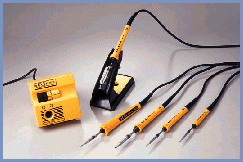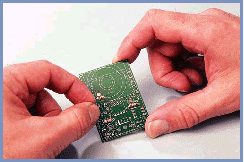|
|
The handle and power cord completes the
soldering iron. Various handle styles are available. The power
cord is often insulated with PVC, but this can be damaged and will
melt if touched by a hot soldering iron. Therefore silicone rubber
insulated power leads are extremely popular for long life and
electrical safety.

The strength or power of a soldering iron is usually expressed in
Watts. Irons generally used in electronics are typically in the
range 12 to 25 Watts. The most popular irons for use in schools or
for hobbyist electronics are the 18 and 25 Watt versions.
It must be remembered that a 25 Watt iron will not run hotter than
a 12 Watt iron, but it will have more power available to quickly
replace heat drained from the iron during soldering. Therefore,
the bigger the component being soldered, the greater the need for
“quantity of heat”, the higher the power needed.
Most irons are available in a variety of voltages. 12V, 24V, 115V,
and 230V are the most popular. You should always use much safer.
As your soldering skills improve, you may work with temperature
sensitive devices such as integrated circuits. For these
applications a temperature-controlled soldering iron (TCS) should
be used.
For bench work a soldering station may be used. This incorporates
temperature selection, optional digital temperature readout, 24V
transformer, an iron holder, and a sponge, all within a neat bench
unit.


1. Twist lead if multi-stranded and tin the area to be soldered.
2. Bend the lead to fit the position on the PCB. Do not bend too
close to the component body as damage to the component may occur.
3. If the component is temperature sensitive use a pair of pliers
as a heatsink between the component body and the point to be
soldered. 4. Tin the site where the component is to be soldered.
 |
|
![]()